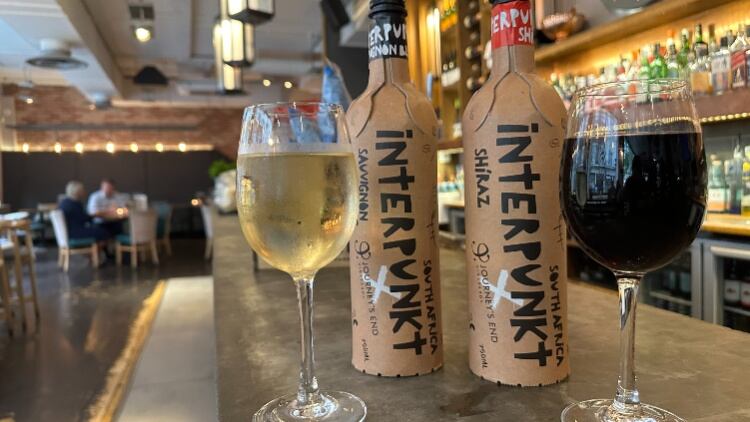Frugalpac is the Ipswich-based business looking to make a big splash in the world of wine and spirit packaging.
Its paper bottles may be shaped like the traditional wine or spirit bottles that we have become accustomed to seeing on supermarket shelves, but their appearance, touch and feel is something very new and different.
Switching glass for paper
Manufactured from recycled paper, these bottles can be found in 25 countries around the world, largely spread across Europe and North America. To date, 36 drink manufacturers use Frugalpac bottles to package their products, with a total of 128 unique ranges now on sale.
Current chief executive Malcolm Waugh joined the business in July 2018 and two years later, Frugalpac commercially launched its first paper botte. Then, in November 2020, Scotland became the first country in the world for wine to be sold from a paper bottle when Frugalpac bottles containing a red from Cantina Goccia vineyard in Italy went on sale at Woodwinters Wine and Whiskies stores in Edinburgh.
Prior to arriving at Frugalpac, Waugh worked in packaging for more than 20 years with Tetra Pak and Essentra and was immediately hooked by the concept and its potential.
“What Frugalpac does is look for problems caused by the incumbent packaging used in the food and drink industry, and once we've identified an issue in the market, we try to find a solution,” he told Food Manufacture.
Now with Frugalpac for more than five years, Waugh is passionate about the product and was keen to discuss the advantages of using paper instead of glass to create drinks bottles.
“Almost 50% of the carbon emissions associated with the wine industry come from its packaging, which is an exceptionally high percentage,” he said.
“Wine making is not an overly industrial process, so the team saw the potential impact creating an alternative to glass could have in terms of improving sustainability.”
While ‘bag in box’ and canned options still exist, Waugh and his team felt that these alternatives had failed to resonate with consumers, leading to the continued predominance of glass bottles.
“We felt if we could create a packaging product that looks and acts like a glass bottle, then consumers would be a little bit more in favour of adopting it,” he added.
Creating a Frugalpac bottle
Each bottle uses recycled paper as its main medium and has a flexible film inside used to protect the paper from liquid. The film can easily be separated from the paper and is certified recyclable.
“We started with the easy to recycle premise, but then looked at working out how the package can help reduce carbon emissions,” Waugh recalled.
“The crux was using recycled paper, which now makes up 84% of each bottle. That is a high content of recycled material and higher than glass bottles, which surprises a lot of people.”
The results of these efforts are impressive, with a Frugalpac bottle producing six times less carbon than a glass bottle. This translates to around 420 to 430 fewer grams of carbon per bottle.
The use of paper also makes the finished product lightweight at just 83g, compared to the lightest glass bottle available which weighs in at around 345g. The weight saving means more bottles can be transported at once, with less fuel used in the process.
“In addition to the sustainability considerations, the look and feel of the bottle is really important,” Waugh noted.
“It stands out alongside other wine and spirit bottles on supermarket shelves because of its colour, while the lightweight feel tested well among shoppers. Additionally, 65% of people we surveyed said they would buy wine from a paper bottle, with just 5% saying they would not.”
As of mid-August 2023, every paper bottle on the market was produced at the firm’s factory in Ipswich using its proprietary machine. However, this will not be the case for much longer, as Frugalpac has sold two its machines to companies in North America.
The first was purchased by Canadian firm KinsBrae Packaging in June 2022, before a second was sold to the Monterey Wine Company in California, USA, earlier this month (August 2023). The machine sold to KinsBrae Packaging will be delivered in September and should be operational one month later.
“Currently, we are shipping a lot of bottles to North America, but that volume will switch to our customers in the US and Canada once they are operational,” Waugh said.
“We have had more than 100 enquiries for bottle machines, as well as 10 customers that are very close to committing to contracts and orders. I'd be disappointed if we haven’t sold another three by the end of the year and maybe another eight or nine next year.”
Collaboration with customers
The growing success and popularity of the paper bottles is testament to the product’s quality, but also owes something to the wine and spirit manufacturers that Frugalpac has partnered with.
Waugh estimates that as of July 2022, business was split 60:40 between spirits and wine. However, thanks to the success of partners such as Interpunkt and When in Rome, that ratio has been reversed in the favour of wine.
That is not to say that the bottles are losing popularity with spirt makers. In fact, Frugalpac has doubled in value over the past 12 months due to growth in both categories.
“If you look at us by value, North America is our is our biggest market simply because we have sold two machines in those regions, on top of the bottles,” revealed Waugh.
“In terms of value, Europe and then the UK would rank second and third. However, looking at volume, the UK is number one, followed by Europe and North America.”
Interpunkt – which produces wine in tandem with South African vineyard Journey's End – is now sold in almost 1,000 bars and restaurants across the UK, after the brand unveiled its first range of wines, a Shiraz and Sauvignon Blanc, last July.
Both products have been bottled by Frugalpac since their launch, and founder Andrew Ingham told Food Manufacture that the Ipswich-based firm’s sustainability credentials appealed to him during the process of selecting a packaging partner.
“I chose Frugalpac specifically because I like the minimal use of plastic,” Ingham said.
“There is no magic bullet to solve all the problems in one go, but it’s about using much less carbon to produce and distribute [the wines]. Other sustainable packaging I looked at used way too much plastic, in some cases almost 50% plastic.”
Interpunkt’s brand identity is focused on removing the tradition and pretension from the wine industry and Ingham believes the partnership with Frugalpac helps achieve this goal.
“When I founded Interpunkt, I felt there were two main challenges to overcome,” he explained. “Firstly, making wine more accessible to casual and new drinkers, by removing all the stuffy wine language and the constant drive to educate customers. And secondly, finding packaging that is better than glass.
“I wanted to have a product that could be found on a supermarket shelf easily, can sit on a dinner table and tastes great. The Frugalpac bottle allows all those goals to be met.”
Meanwhile, Anglo-Italian brand When in Rome sells wine in three formats: cans, bag in box and Frugalpac bottles. The partnership was forged between the two businesses in December 2021, and When in Rome has gone from strength to strength since.
Its range of Italian wine is now stocked by UK supermarkets including Waitrose and Sainsbury’s, as well as online delivery service Ocado. The brand also supplied the UK leg of Coldplay’s recent world tour.
“Frugalpac is offering a solution that no other business in the UK is,” When In Rome chief executive, Robert Malin, told Food Manufacture.
“We have a very similar ethos focused around reducing the carbon footprint of wine production, while we are both start-ups that look to support each other. Like us, they [Frugalpac] understand the importance of building up this category, and the success of their bottles will help us in the long run.”
Cantina Goccia, the vineyard responsible for the first Frugalpac wine bottle sold back in 2020, has also benefited from the partnership. According to Waugh, the wine maker is projected to sell 85,000 Frugalpac bottles this year alone, having only sold 10,000 glass bottles per year prior to beginning the partnership in 2020.
“[Goccia’s] business has grown significantly and they're still selling 10,000 glass bottles a year on average,” Waugh added.
“So, it hasn't cannibalised what they're doing, it's just enhanced their offering. They have grown in existing markets, like the UK and Scandinavia, but they have also started to export.”
Paper bottle market leader
At this stage, Frugalpac says it’s the only brand on the market selling and distributing paper wine and spirit bottles, although Waugh mentioned that Danish firm Paboco and UK company Pulpex are looking to break into the space.
Paboco and Absolute Vodka are currently involved in a three-month trial with Tesco, where its bottles are stocked in a limited number of stores.
“Paboco’s proposition is slightly different to ours, but it's flattering to be followed and it really gives us confidence that we're heading in the right direction,” Waugh said.
“It is backed by big companies like Coca-Cola, which is keen to bring this type of product to market. Paboco also uses pulped paper, where pulp is formed into a bottle using moulds. It's quite energy intense, needs a lot of dewatering and it's a difficult material to find the right consistency.”
Looking ahead, Waugh and the Frugalpac team is aware that there will be more entrants to the market, but they believe that their head start on the competition puts them in an enviable position. Nonetheless, no one is getting carried away with the early success and a sense of realism remains.
“Glass will be there and it's going to take time to make a wholesale change,” Waugh acknowledged.
“You could argue that our ambitions are a little underwhelming, but I want to temper expectations. There are 21bn Bordeaux style glass bottles sold every year, so even a single digit market share would be huge for us and the sustainability of the industry. I don’t think a 2-3% share is unreasonable in five years.”
As it seeks to grow, Frugalpac has continued developing its technology and work has begun on the next generation bottling machine. The goal is to produce more bottles than is currently possible, while also bringing the cost of packaging down.
Waugh concluded: “With the Bordeaux bottles, plus the 13 billion spirit bottles sold, that 34bn bottles of possibility each year. That is a lot of carbon removed from the wine and spirit sector.
“It could have a huge impact.”





